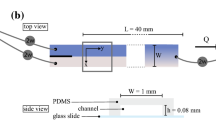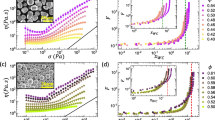Abstract
Flow experiments through capillaries with 0.2% xanthan in aqueous solution and 0.1 N NaCl brine were carried out to study the influence of the molecular conformation on the flow development at relatively low shear rates, from 20s−1 to 400s−1. Capillaries with a wide range of length-to-diameter ratios, L/D = 4.5 to 1015 were used.
The apparent viscosity as a function of L/D at a constant shear rate shows a continuous decrement of the viscosity as L/D increases, until an asymptotic value is reached. The decrement in the apparent viscosity is partially explained in terms of slip. It was found that slip is a function of L/D as well as shear stress, i.e., slip develops during flow, thus inducing spatial anisotropy in the fluid until a stable state is reached. However, the substantial difference in apparent viscosity between short capillaries and capillaries longer than 300 D may be attributed to dominant elongational flow due to the contraction in the small capillaries and slip in long capillaries.
The flow in a sufficiently long capillary can be divided in four regions rather than three, as is usually assumed. In the first region, which corresponds to the entry, elongational and shear flow coexist and elongational flow dominant. In the second region, end effects and slip development are coupled. In the third region the flow is fully developed and end effects are negligible. However, the fluid shows physical characteristics different from those of the fluid at rest, as a consequence of prior slip development. The fourth zone is the exit region in which the velocity rearranges due to the change of boundary conditions. The length of each region depends on the conformation of the macromolecules and shear rate. In addition, it was found that the stiffness of xanthan increases with the increase of the ionic strength.
Finally, a performance of Bagley's analysis in the whole range of L/D studied showed that the use of the Bagley correction is not a reliable way to correct for end effects when the flow is not fully developed and/or in the presence of slip.
Similar content being viewed by others
References
Bagley EB (1957) End corrections in the capillary flow of polyethylene. J App Physics 28:624–627
Binding DM (1988) An approximate analysis for contraction and converging flows. J Non-Newtonian Fluids 27:173–189
Chauveteau G (1982) Rodlike polymer solution flow through fine pores: influence of pore size on theological behaviour. J Rheol 26:111–142
Chow A, Fuller GG (1984) Response of moderately concentrated xanthan gum solutions to time-dependent flows using two color flow birefringence. J Rheol 28:23–43
de Vargas L, Manero O (1989) On the slip phenomenon of polymeric solutions through capillaries. Polym Eng and Sci 29:1232–1236
Funatsu K, Mori Y (1970) On the viscoelastic flow of polymer melts in the nozzle and reservoir. Proc 5 th Int Cong on Rheol 4:537–550
Galindo E, Torrestiana B, Garcia Rejón A (1989) Rheological characterization of xanthan fermentation broths and their reconstituted solutions. Bioprocess Eng 4:113–118
Gottlieb M (1978) Ph D Dissertation. Chem Eng. University of Wisconsin-Madison
Mooney M (1931) Explicit formulas for slip and fluidity. J Rheol 2:210–222
Stokke BJ, Smidsrod O, Elgsaeter A (1989) Electron microscopy of native xanthan and xanthan exposed to low ionic strength. Biopolymers 28:617–637
Tinland B, Rinaudo M (1989) Dependence of the stiffness of the xanthan chain on the external salt concentration. Macromolecules 22:1863–1865
Walters K (1975) Rheometry. Chapman and Hall, London
Author information
Authors and Affiliations
Additional information
Dedicated to Arthur S. Lodge at the occasion of his 70th birthday and his retirement from the University of Wisconsin.
Rights and permissions
About this article
Cite this article
Pérez-González, J., de Vargas, L. & Tejero, J. Flow development of xanthan solutions in capillary rheometers. Rheol Acta 31, 83–93 (1992). https://doi.org/10.1007/BF00396470
Received:
Revised:
Issue Date:
DOI: https://doi.org/10.1007/BF00396470




